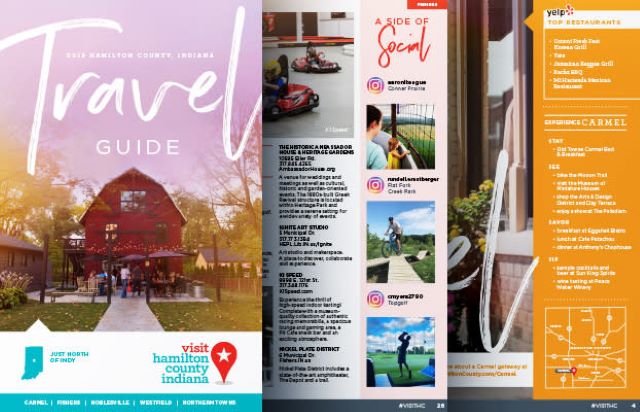
Image source: Visit Hamilton County
Despite the prevalence of digital information, print dominates travel destination guides.
Nearly 70% of non-local visitors make at least one trip to the destination after receiving a printed guide, according to research by Destination Analysts. More than 50% of U.S. travelers consult printed material while making their travel decisions, according to The State of the American Traveler.
“Based on these findings, devoting some of your marketing budget to create a well-designed, attractive publication can result in good return on your investment,” says Camille Leonard, creative director at Stamp Idea Group.
While visitor guides typically include online versions, more travelers seem to prefer the print versions, agrees Ashley Lowe, founder and principal of Betty Ashley Public Relations.
PR and marketing pros specializing in destination marketing recommend these practices for destination marketing organizations (DMOs).
Focus the cover imagery. The cover image or images set the tone for the entire publication. Select images that are visually interesting, supports your brand and conveys a sense of place. A skyline or shoreline isn’t always the answer. “Move in closer to share a glimpse of what might attract visitors to your destination and remember to choose an image that allows for your masthead to be legible and dynamic,” Leonard says.
Immerse yourself in the local experience. A superb destination guide requires first-class writing as well as photography. Don’t reproduce the same general information already available on Wikipedia. You don’t need to be create an encyclopedia – and probably shouldn’t. Instead, delve into local experiences, focusing on where to eat, shop and explore.
Tap your story-telling abilities to convey a sense of the charm, adventure or beauty that the community offers. Interview historians, chefs, civil rights pioneers, and other experts for in-depth local knowledge. Consider relating how historic buildings were transformed into new uses, such as restaurants, shops or breweries. Find and relate what’s unique to the locale.
Customize content. A leading trend in destination marketing is creating targeted content for specific groups. Besides separate publications for businesses travelers and families, a DMO might craft specialized content for bird watchers, scuba divers, or art aficionados. Digital printing now makes small-quantity production affordable, allowing DMOs to publish guides with specific visitors in mind, Leonard notes.
Destination Think! Marketing Manager John Freeman puts it this way: “Something for everyone is nothing for anyone.”
The visitor guide for Tualatin Valley, Ore. includes itineraries geared toward specific types of travelers and vacations — such as business travelers, cultural travelers and girlfriend getaways. VisitMadison uses visual storytelling that appeals to moms traveling with kids and convention-goers with a half day to explore the town in Wisconsin, Lowe notes.
Design a user-friendly map. The best maps provide quick and simple visual references to make decisions about where to stay and eat, what to do and see, and how to get to places. Self-guided tours, bolstered with story-telling, enhance the visitor experience. If the city is large enough, maps of districts or neighborhoods, also enhance the experience. Craft stories that provide context that visitors won’t find on their GPS.
“Digital maps provide data, not context,” says David Archer, editorial manager at Destination Think! “Google Maps doesn’t know your destination’s story, and why you’d love to turn off the main road to see a hidden lookout point that would otherwise pass you by.”
Think carefully about ads. While ads can sometimes provide helpful information, integrating them into the design can be tricky. Instead of laying out fractional page display ads, consider a section of advertorials that relay information in an editorial style. “This editorial strategy gives a more conversational tone to the content of your visitor guide,” Leonard says.
Use digital media to promote the destination guide. With proper SEO, the destination’s own web page should rank at the top of Google search results. Promote the print destination guide on the home page. Also promote the website and the destination guide on social media. Encourage local businesses and residents to promote their “home town” on their own social media accounts.
Encourage user-generated content. Some examples: Nevada’s visitor guide features extensive user-generated content from paid partnerships and local residents; Visit Alexandria highlights its “Top 5 Photo Spots” for visitors taking photos in the city.
Grow your list. Marketers are roughly evenly split on requiring email addresses and other personal information for visitor guides, Lowe says. Consider how important it is for to capture user information — including those valuable email addresses — versus offering easy access for readers.
Listen to your visitors. Input from visitors can provide valuable information. In response to visitor feedback, “Visit Alexandria” reduced the size of its guide to fit more easily in a purse or pocket.
Bottom Line: Both research and anecdotal accounts report that printed visitor guides successfully entice travelers to visit the destination. But regurgitating well-known facts in an encyclopedia-like format will likely flop. Effective destination guides require first-class photos, research and writing and customizing content to meet the needs of specific types of visitors.
William J. Comcowich founded and served as CEO of CyberAlert LLC, the predecessor of Glean.info. He is currently serving as Interim CEO and member of the Board of Directors. Glean.info provides customized media monitoring, media measurement and analytics solutions across all types of traditional and social media.




